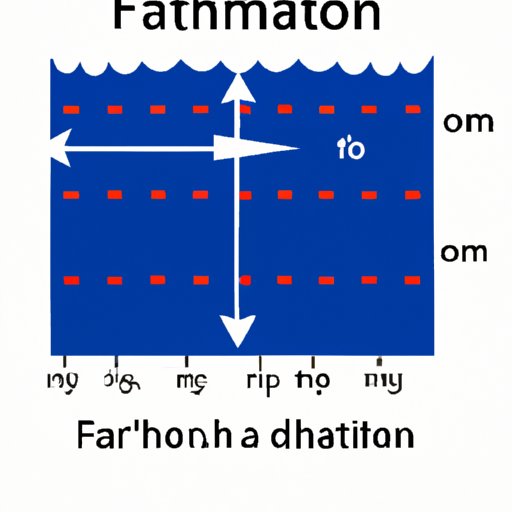Introduction
When it comes to measuring depth, distance, or the fabric, a fathom has been a widely used unit of measurement in various sectors of life. From nautical navigation to everyday use, understanding what a fathom is and how to use it can make a big difference. However, the word “fathom” may not be as commonly used in current times as it was in the past, and some might have a vague idea of what it means. This article dives deep into the meaning and versatile applications of fathom to provide a better understanding of its importance.
A Deep Dive: Understanding the Meaning and Origins of the Word “Fathom”
The word “fathom” originated from the Old English word “faethm”, which referred to the extent of a pair of outstretched arms. The Middle Dutch word “vadem” meaning “a measure of around six feet” is another prominent root of the word.
The original meaning of the word “fathom” was “the distance that a person’s outstretched arms, typically measuring around six feet, could reach.” From ancient times, fishermen have used a fathom to measure the depth of the water using a rope or cord with knots at fixed intervals of six feet.
Over time, the word “fathom” has evolved to signify a measurable unit of length or depth which is six feet or 1.8288 meters. The meaning of “fathom” has come a long way during its development, and it now has a more standardized definition in various sectors of life.
From Nautical Navigation to Everyday Use: Exploring the Versatile Definition of Fathom
Today, a fathom is known as a unit of measurement primarily used to measure a depth of water. Historically, six feet meant the distance someone could reach with their arms, making it a common unit of measurement for a distance of sea depth, especially among fishermen.
In addition to measuring the depth of water, a fathom has many other versatile applications. One of the most notable applications of fathom is its use in the measurement of fabric. The standard measure for fabric is usually 36 inches or one yard. A fathom of fabric is equal to two yards, or six feet.
Fathom can also be used to estimate one’s height, especially in old times, by extending arms and measuring the length of an individual. Similarly, in-depth analysis of the word’s origins indicates uses such as “a way to understand” or “know” during the olden times when fathom originally came into use.
Measure Up: How Many Feet and Yards are in a Fathom?
Considering the fact that most people are familiar with yards and feet as units of measurements, understanding how fathom is measured in these units can be helpful.
As noted earlier, a fathom is defined as six feet long, which is equivalent to 1.8288 meters. One yard is equal to three feet, so two yards make up one fathom. Six feet, or two yards, is the typical length of a fathom, which can help in the application of it as a unit of length measurement.
Comparatively, a fathom is longer than a couple of regular instruments of measuring length such as a ruler or tape measure that are 1 foot and 25 feet long, respectively. However, it is shorter than other measures such as a chain or cords used for distance measurement that could be as long as 66 feet.
Fathom: The Forgotten Unit of Measurement Making a Comeback
Although the word “fathom” may not be commonly heard today, it is not completely forgotten and still sees use in numerous modern applications.
One of the most diverse applications of the fathom is within the maritime and fishing industry, where it is used for tasks like measuring the length of nets and estimating the depth of the ocean.
Many of the provisions used by the navy refer to the fathom as a unit of length. However, various industries and professionals such as scientists, geologists, and even aviators use fathom for specific measurements that require a precise depth or length.
The Many Applications of Fathom: From Fishing to Science and Beyond
As previously noted, the maritime industry is one of the most common users of fathom because it is particularly useful in measuring and understanding the ocean’s depth.
In scientific research, fathom is used as a unit of measurement to understand ocean depth and the geology of the seabed, thereby proving useful for fields like oceanography and geology.
Other industries, including construction, textiles, and fashion, use fathom to calculate fabric measurements, including curtains’ length.

Fathoming the Depths: A Brief History and Explanation of Fathom
The history of the use of fathom can be traced back to ancient civilizations, where the unit of measurement was used in everyday life. The use of fathom as a unit of length measurement became popular in maritime navigation in the 16th century because there was a deeper understanding of the ocean depth’s importance during that time.
Today, fathom has become an essential unit of measurement used in science, construction, and even daily life.
Gauging Depth: How Fathom Became a Standard Unit of Measurement for Oceanographic Research
The importance of fathom as a unit of measurement in oceanographic research cannot be overemphasized. As the focus of the researchers shifted away from traditional methods of oceanic exploration, the concept of measuring the depth of the ocean with a fathom cord gained more prominence.
In many significant scientific discoveries of the past century, scientists have used fathom to understand the ocean floor, geology, and marine life beneath the water surface.
Conclusion
In conclusion, the fathom, being an ancient unit of measurement, may have lost its significance in daily life. However, it remains important in specific fields such as oceanography, fisheries, scientific research, and geology. This article has explored and explained the meaning of fathom, its varied applications, and how it came into being. Additionally, the article explained why a better understanding of fathom is important and how it can make a significant difference in different sectors of life.
